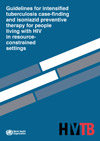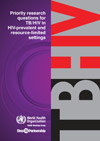Nation-wide scale up
TB is the most common presenting illness among people living with HIV. At least one-third of the estimated 34 million people living with HIV worldwide is infected with the TB bacteria (latent TB infection - not active disease). Of the estimated 8.7 million TB cases in 2011, 1.1 million (13%) were also living with HIV. The WHO policy on TB/HIV outlines 12 collaborative activities that HIV and TB programs must implement in order to deliver appropriate services for people with TB and HIV co-infection. Rapid nationwide implementation of the 12 collaborative activities is now urgently needed.
In 2011 only 3.2 million people were screened for TB, representing a small proportion of those enrolled in HIV care. Despite WHO recommendations to initiate ART in all TB patients living with HIV irrespective of CD4 count, globally only 48% of TB patients found to be HIV-positive in 2011 were provided with life-saving ART, compared with around 58% of all eligible adults living with HIV on ART. We are far from reaching the Global Plan to Stop TB 2011-2015 targets of 100% and TB is still the number one killer of people living with HIV, accounting for a quarter of all HIV-related deaths. The gaps are still large and without a concerted effort by both TB and HIV communities and rapid scale-up in regions such as the Asia Pacific we will not achieve the targets set for 2015.
A. Establish and strengthen the mechanisms for delivering integrated TB and HIV services
- A.1. Set up and strengthen a coordinating body for collaborative TB/HIV activities functional at all levels
- A.2. Determine HIV prevalence among TB patients and TB prevalence among people living with HIV
- A.3. Carry out joint TB/HIV planning to integrate the delivery of TB and HIV services
- A.4. Monitor and evaluate collaborative TB/HIV activities
B. Reduce the burden of TB in people living with HIV and initiate early antiretroviral therapy (the Three I’s for HIV/TB)
- B.1. Intensify TB case-finding and ensure high quality antituberculosis treatment
- B.2. Initiate TB prevention with Isoniazid preventive therapy and early antiretroviral therapy
- B.3. Ensure control of TB Infection in health-care facilities and congregate settings
C. Reduce the burden of HIV in patients with presumptive and diagnosed TB
- C.1. Provide HIV testing and counselling to patients with presumptive and diagnosed TB
- C.2. Provide HIV prevention interventions for patients with presumptive and diagnosed TB
- C.3. Provide co-trimoxazole preventive therapy for TB patients living with HIV
- C.4. Ensure HIV prevention interventions, treatment and care for TB patients living with HIV
- C.5. Provide antiretroviral therapy for TB patients living with HIV
For meetings related to regional and nationwide scale-up please click here.




 Intensive case finding and isoniazid preventive therapy guidelines, 2010
Intensive case finding and isoniazid preventive therapy guidelines, 2010
 Priority research questions for TB/HIV in HIV-prevalent and resource-limited settings, 2010
Priority research questions for TB/HIV in HIV-prevalent and resource-limited settings, 2010